2. GHANA
Manufacturers face tough times ahead
As the timber industry restarted operations after the
holidays they learnt from the Ghana Statistical Services
that December inflation came in at 17.7%.
Along with increased taxes, higher utility costs and rising
fuel costs prospects for a profitable year receded and
companies are scrambling to adjust to the worsening
situation which is affecting employers, employees and
consumers.
Manufacturers also have to deal with yet another challenge
每 depreciation of the cedi. Since the beginning of business
in the New Year the local currency has depreciated by
some 3.9% causing many to doubt if they will break-even
this year.
Economists anticipate the cost of borrowing could rise to
26% when the Monetary Policy Committee of the Bank of
Ghana next meets. Analysts point out that a further
increase in the prime rate could lead to higher inflation in
turn leading to higher prices in the domestic market.
The pressure on the cedi stems mainly from fears
that the
economic trends are still volatile and need to be stabilsed
quickly. In its latest staff report the IMF said Ghana*s
economic recovery will depend heavily on addressing the
current power crisis. If this is achieved the way forward,
according to an economist Kwame Pianim, is expansion of
exports.
Widening trade deficit with China
The Chinese Ambassador to Ghana, Ms Sun Baohong
said the value of trade between Ghana and China in 2015
rose to around US$6 billion. She also commented on the
increased use of Chinese technologies by Ghanaian
companies, a trend she hopes will grow as investments
from China*s US$60 billion dollar support for African
countries begin to flow.
The Ambassador reported that not only did the 2015
China-Ghana increase but there was significant investment
by China in engineering projects in Ghana such that of all
China*s investments in Africa those in Ghana where the
highest.
However, despite the growth in Ghana-China trade Ghana
recorded a trade deficit in 2015. According to Bank of
Ghana exports amounted to around US$2.4 billion (mainly
from oil, gold and agricultural products) while imports
cost almost US$4 billion.
Ratify Trade Facilitation Agreement says Chamber of
Commerce
The Ghana Port Authority has said revenue from transit
trade has been falling as neigbouring countries switch to
lower cost ports in the region such as Abidjan, Dakar and
Conakry amongst others. Transit shipments via Ghana*s
ports began to decline when trucking regulations were
tightened and the Port Authority saw trans-shipment
volumes drop by around half to 500,000 tonnes annually.
The issue of high transaction costs was raised by Mr.
Emmanuel Doni-Kwame, a spokesperson for the &Alliance
for Trade Facilitation* under the International Chamber of
Commerce (ICC Ghana). The Alliance is urging the
government to ratify and implement the recently proposed
Trade Facilitation Agreement as this would have a major
impact on Ghana*s export competiveness.
For more see:
http://www.newsghana.com.gh/transit-trade-in-wa-via-ghanaslumps-
to-50/
and
http://www.newsghana.com.gh/trade-facilitation-agreement-willraise-
export-revenue/
January prices
Prices for wood products remained unchanged as of 30
January.
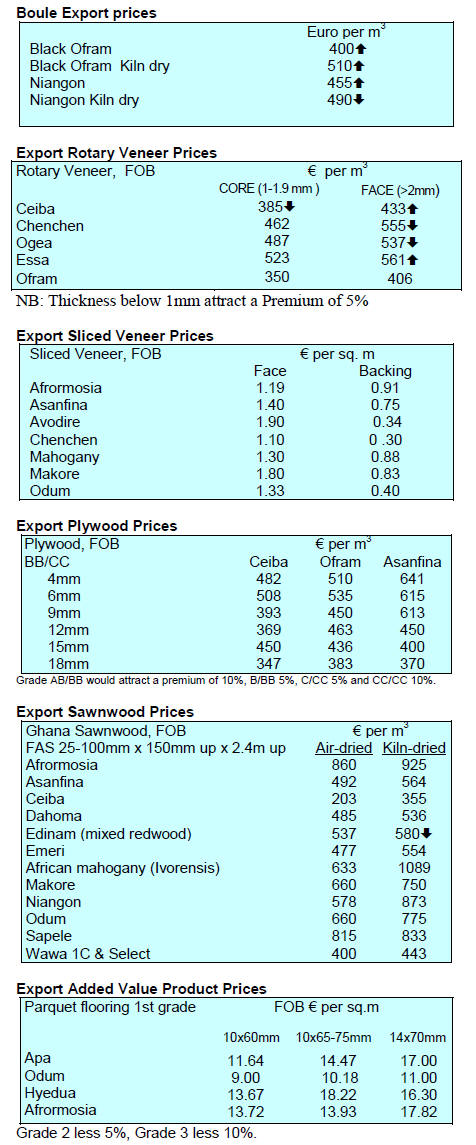
3. MALAYSIA
Ringgit claws back some gains 每 prospects
for further
strengthening improve
The ringgit/US dollar exchange rate strengthened to a
three month high on the back of stabilisation in oil prices
and as traders welcomed the government*s budget realignment.
The Malaysian currency advanced against all
10 major currencies in the last week of January especially
the Indian rupee and South Korean won.
Pace of CoC certification applauded by PEFC
The Malaysian Timber Certification Council (MTCC) has
received an award from PEFC (Programme for the
Endorsement for Forest Certification) for the third highest
increase in the number of Chain of Custody (CoC)
certified companies in 2015.
Yong Teng Koon Chief Executive Officer at MTCC
reported that the MTCC registered 59 new CoC certificate
holders representing a 21% increase compared to 2014.
In a statement MTCC has indicated it would work to
ensure more domestic wood product end-users such
construction and building companies, furniture makers as
well as manufactures of composite boards and paper have
in place systems to secure raw materials from sustainably
managed forests.
Plantations to be at core of expansion of industry in
Sarawak
The Shanghai Taison Pulp-Making Group is considering
establishing a pulp and paper mill in Bintulu, capable of
handling as much as two million tons of pulp annually.
When complete the new complex could create over 10,000
job opportunities in the mills and in the plantations which
the company intends to establish.
Sarawak's plantation log production is set to rise to around
three million cubic metres in five years according to the
Sarawak Forestry Department. A Sarawak Timber
Industry Development Corporation (STIDC) publication
shows that plantation log production was over
530,000cu.m 2013. The STIDC plans to expand its
plantations areas to one million hectares by 2020.
Currently wood-based industries in Sarawak are mostly
primary processors producing plywood, sawnwood and
veneer from natural forest logs but, as natural forest
harvesting is scaled back, further expansion of these mills
is unlikely. However, as plantation resources become
available production of other primary and even secondary
products becomes a viable proposition.
New Deputy CEO for Malaysian Timber Council
In a press release the Malaysian Timber Council (MTC)
has announced the appointment of Richard Yu as Deputy
Chief Executive Officer.
Mr. Yu, a MBA holder from the University of Bath, will
be working with Chief Executive Officer Datuk Dr. Abdul
Rahim Haji Nik to lead the Council in their efforts to
further develop and promote the Malaysian timber
industry.
Mr. Yu was a Senior Director of one of Bank Negara*s
companies and has acted as advisor on areas corporate
finance, strategy and policy development, human resource
and talent management, risk management and ethics.
See: http://mtc.com.my/wp-content/uploads/2016/01/MTCAppointment-
of-Deputy-CEO.pdf
4. INDONESIA
Wood products at core of export growth
plan
An overall 9% growth in exports is the aim of the
Indonesian government for 2016 and greater emphasis will
be on non-oil exports. To support export growth the
government is improving infrastructure and has begun
deregulation to promote investment.
Ani Mulyati, of the Ministry of Trade said textiles and
wood products such as furniture and handicrafts will be at
the core of export growth in 2016.
Nus Nuzulia Ishak, DG for Export Development at the
Ministry of Trade, said special attention would be given to
developing markets in the Middle East especially Kuwait
and Saudi Arabia where Indonesian textiles, furniture and
other wood products were appreciated .
Head of Peat Restoration Agency appointed
At the 2015 Climate Change Conference (COP21)
President Joko Widodo announced the establishment of a
Peatland Restoration Agency charged with restoring fire
damaged peatlands. The new agency has been established
under Presidential Regulation No. 1 of 2016, dated
January 6, 2016.
To launch the new agency Nazir Foead, Conservation
Director at the World Wildlife Fund, has been appointed
as the head of the new agency.
The agency will prepare an action plan to restore fire
damaged peat lands in Riau, Jambi, South Sumatra, Papua
and across Kalimantan.
According to the World bank, last year, forest fires in
Indonesia resulted in a loss to the economy of around
US$16 billion or about 1.9% of Indonesia's GDP.
Interest rate cut
In a press release it was announced that the Board of
Governors of the Bank of Indonesia proposed a lowering
of interest rates to 7.25%.
This, said the Bank, was in line with view that there was
an opportunity for monetary easing as the macroeconomic
indicators remain stable. It is possible that further easing
will be introduced after an assessment of the domestic and
global economy.
Bank Indonesia Governor, Agus Martowardojo, said
that
while Indonesia*s economy had improved he will carefully
watch developments in the Chinese economy to assess
impacts on Indonesia since China is one of Indonesia*s
main trading partners.
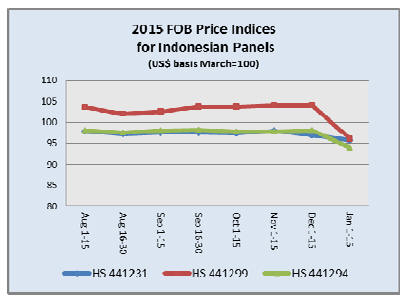
5. MYANMAR
Commercial tax on timber
The Myanmar government has introduced new tax
structures. Under the new law a 25% sales tax will be
applied on sawn timber defined as 10 inch by 10 inch and
up of both teak and hardwoods. However, it is not clear
how the MTE will apply this. In fact, currently the MTE
include and collect a sales tax in their selling price.
One analyst said that the commercial tax was to be borne
by the buyer but if the MTE tries to collect an additional
tax on the sale of timber this will seriously affect the
competiveness of the industry.
Myanmar national timber plan
At a recent meeting with the Ministries of Forestry and
Commerce the private timber sector was invited to advise
on the content of the planned Myanmar Timber Industrial
Plan which is part of the National Economic Strategy
proposed by the Ministries of Forestry and Commence.
Investment by China in timber industries
According to the local media the Permanent Secretary of
the Ministry of Forestry is set to reject the proposal from
the China for setting up of a wood processing zone in the
northern border area with the aim of eliminating illegal
trading across the border. According to media reports over
100 NGOs and civil society organisations raised concern
on the plan.
Fixed exchange rate for import-export
The Custom Department has announced that the weekly
fixed exchange rate would be applied when calculating
taxation on items for import and export.
January teak prices
A total of 142 cubic tons of sawn teak was sold by open
tender at the January 2016 auction. Average prices are
shown below:
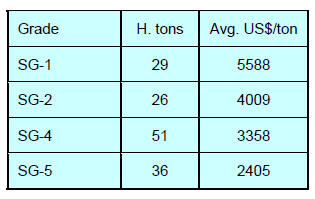
6.
INDIA
Inflation rate trends down
The Office of the Economic Adviser (OEA) to the Indian
government provides trends in the Wholesale Price Index
(WPI).
The official Wholesale Price Index for all commodities
(Base: 2004-05 = 100) for November rose 0.5% to 177.6
from 176.7 in October. The year on year annual rate of
inflation, based on monthly WPI, stood at 每1.99
(provisional) as of November 2015 compared to -3.81
based on data up to October.
For more see:
http://eaindustry.nic.in/cmonthly.pdf
Timber and plywood price indices climb
The OEA also reports wholesale price indices for a variety
of wood products. The wholesale price indices for Wood
Products and Plywood are shown below.

Home sales fall in major Indian cities
Knight Frank India has just released its 2015 half-yearly
report on the 2015 India real estate market. This offers a
comprehensive view on the residential and office market
performance across seven cities for the period between
July每December 2015.
The headline is that 2015 ended with the lowest level of
housing starts and sales since 2010 however in the office
market the picture was quite different as occupancy rates
soared to their highest in years.
Home sales in the eight major cities fell 4% in 2015 to
come in at the lowest level since 2010 despite interest rate
cuts by the Reserve Bank of India which served to bring
down mortgage rates. The National Capital Region
continued to be the worst performing market. The report
notes that in the residential market unsold inventory levels
are so high that, at present rates of purchases, it would take
more than 2.5 years to sell all.
On house prices the Knight Frank report notes that there
was a sharp decline in the pace of price increases from 9%
to just 3% over the past 3 years.
For more see:
http://www.knightfrank.co.in/news/2015-ends-with-the-lowestnew-
launches-and-sales-volume-since-2010-for-residentialwhile-
office-market-records-highest-occupancy-at-84.2-
07961.aspx
INDIAWOOD 2016, one of the largest wood technology
shows in Asia
Over 650 domestic and international companies will be
exhibiting at INDIAWOOD to be held 25-29 February
2016 at the Bangalore International Exhibition Centre
(BIEC).
More than 650 companies offering furniture production
technologies, woodworking machinery, tools, fittings,
accessories, raw materials and products will be taking part
in one of Asia*s largest trade fairs for the woodworking
and furniture manufacturing sector.
A press release from the organisers says craftsmen,
woodworkers and furniture manufacturers; distributors,
dealers and manufacturers of hardware and accessories;
plywood and particle board manufacturers and traders;
manufacturers of wood-based products; architects, interior
designers and builders from India and South-East and
South Asian countries will participate in INDIAWOOD
2016.
According to a report from INDIAWOOD, production by
the Indian furniture manufacturing industry is worth
around US$20 billion annually and the sector employs
more than 3 million. people in the organised sector alone.
INDIAWOOD says the industry has seen an annual
growth of around 30% over recent years.
For more see: http://www.indiawood.com/press-releases.html
Greater focus on bamboo
Union Minister, Nitin Gadkari, plans to constitute a
bamboo sub-group under Niti Aayog of the Planning
Commission.
A recent meeting of senior ministers heard that the
domestic market for bamboo is estimated to be worth
around US$10 billion annually and this is set to grow
generating enormous job opportunities along the
production chain plantation development to
manufacturing. Production of ethanol derived from
bamboo for bio-diesel offers other opportunities for
investment.
The government is planning schemes to encourage farmers
to establish bamboo plantations along national highways
and the Road Transport and Highways Ministry has
unveiled a plan for &greening* extending along 100,000
km. of national highways.
K. Bhattacharya, the head of the National Green Highway
project said the world market for bamboo products has
been estimated at around US$360 billion with China and
Vietnam being the main suppliers. He said India*s exports
are no higher than those of the Philippines but could be
much higher.
The government is resolved to increase production of
bamboo to augment wood supplies for housing, furniture,
panel products packaging etc. The Indian Plywood
Industries Research and Technical Institute (IPIRTI ) has
begun work developing technologies for production of
bamboo products.
IPIRTI has already invested several years of research in
development of cost effective, eco-friendly technologies
for manufacture of several bamboo based products such as
bamboo mat board, veneer composites, corrugated sheets
and flooring, including high density flooring that can be
used in containers. At present laminated bamboo lumber is
being imported and is finding applications in the transport
sector especially Indian Railways.
Quality of teak logs results in high auction prices
Auctions at forest depots in South Dangs were scheduled
from 21 December 2015 up to 5 January 2016, but
continued till 9 January. More than 12,000 cu.m of teak
and other hardwoods were sold.
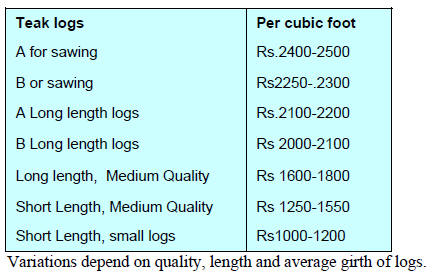
Good quality non-teak hardwood logs, 3 to 4 meters
long
having girths 91cms and up of haldu (Adina cordifolia),
Laurel (Terminalia tomentosa), kalam (Mitragyna
parviflora) and Pterocarpus marsupium logs fetched prices
in the range of Rs.800-900. Prices for medium quality logs
were in the range of Rs.300-350 per c.ft.
The quality of logs was reported as good but several lots
remained unsold as buyers felt that prices were unduly
high.
Teak sales in Central Indian forest depots
Deliveries of teak to all depots of Madhya Pradesh have
been good. Teak logs from areas recently harvested are
mostly of 2 to 5 metre lengths and in girth class 120 cms
and below. Observers say the logs available were of good
form and the timber was of a golden color with black
stripes.
The latest auctions were held at depots in Narmadanagar,
Jabalpur, Hoshangabad and Betul divisions. Over 22,000
cubic metres of teak logs were sold. Buyers were mainly
from local mills plus merchants from Gujarat and South
India. Average prices were higher than the previous
auctions and are shown below.
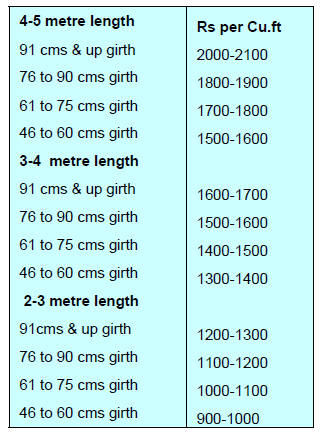
Prices for locally sawn hardwoods
Prices are unchanged from December but prices are
expected to change when new shipments arrive.
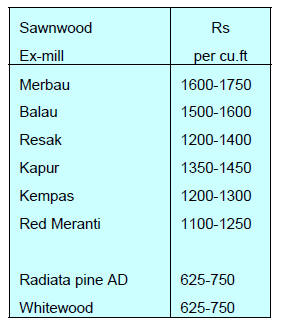
Prices for imported plantation teak, C&F Indian
ports
Demand and international shipments are balanced and
while FOB prices are unchanged landed costs are rising as
the US dollar strengthens against the rupee.
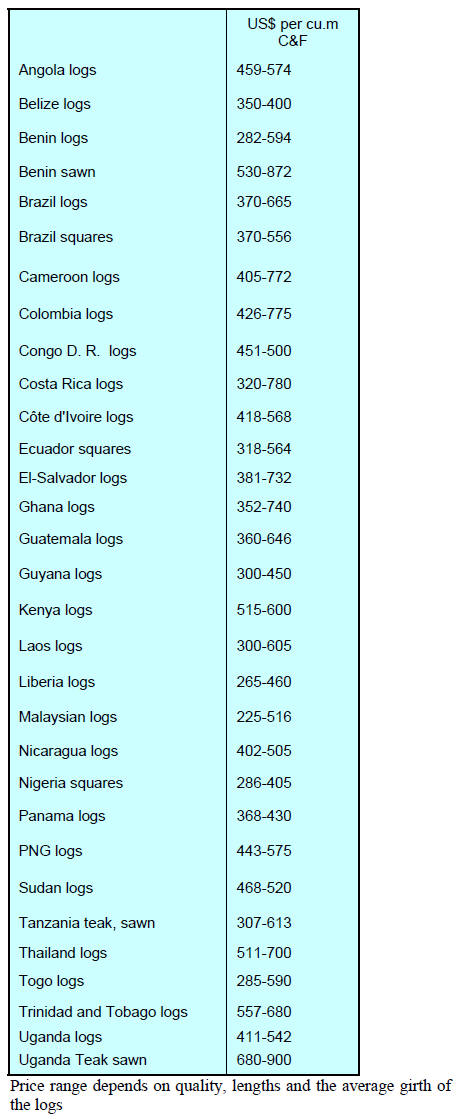
Myanmar teak logs sawn in India
No price movements have been reported.
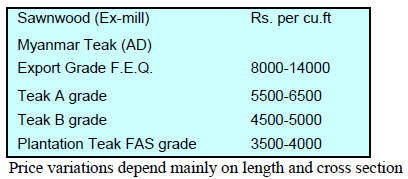
Prices for imported sawnwood
Prices in rupee for imported temperate timbers have been
rising due to the appreciation of US dollar and are likely to
go up further if devaluation of the rupee continues.
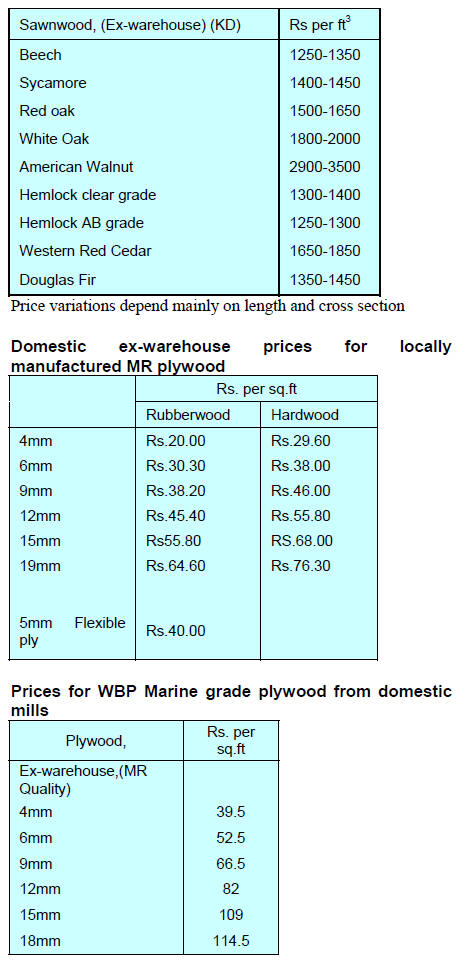
﹛
7.
BRAZIL
Wood product exports at highest level
since 2008
Despite an uninspiring year, Brazil*s 2015 exports of
wood products matched that of 2007. In the case of pine
plywood, exports were over 1.5 million cu.m, or 14%
more than in 2014.
Exports of wood products such as particleboard, MDF and
OSB, traditionally uncompetitive at the international level,
increased significantly as manufacturers were forced to
turn to export markets in the face of weak domestic
consumption.
A measure of success was achieved with exports
especially to the US as the housing market is recovering.
Demand in the US was behind the rise in pine sawnwood
exports while the gains in plywood exports were driven
mainly by rising demand in Europe.
Although wood products export volumes are rising and
further gains are projected the competitiveness of
Brazilian companies is being affected by record inflation
which continues to push up internal costs.
December export performance
Brazil*s December 2015 exports of wood-based products
(except pulp and paper) fell 12.4% in value compared to
December 2014, from US$263.1 million to US$230.6
million.
Pine sawnwood export values increased 27% in December
rising from US$ 21.4 million in 2014 to US$ 27.2 million
in Decmber 2015. In terms of volume, December exports
increased 46% year on year over (90,800 cu.m to 132,300
cu.m.
On the other hand, tropical sawnwood exports fell 34% in
volume, from 38,000 cu.m in December 2014 to 25,100
cu.m in December 2015. The decline was more
pronounced in terms of value where year on year
December exports fell 47% from US$ 22.5 million to US$
12 million.
The growth in value of pine plywood exports could not
match the success of pine sawnwood and declined 12% in
value in December 2015 compared to December 2014
(from US$43.8 million to US$38.4 million). But, the
volume of pine plywood exports increased 25.5%
underlining the weakness in plywood demand at the end of
last year.
In contrast to the trends in pine plywood exports, tropical
plywood exports increased significantly in volume and in
value, from 6,300 cu.m (US$ 3.4 million) in December
2014 to 135,800 cu.m (US$43.5 million) in December
2015.
The much hoped for recovery in demand from Argentina
has not yet been achieved and as a result wooden furniture
exports fell from US$ 41.5 million in December 2014 to
US$ 37.3 million in December 2015, a 10% drop.
Brazilian timber industry prospects in 2016
Brazil*s timber industry experienced a mixed performance
in 2015 as a number of factors affected competitiveness
for example; rising production costs, volatility in the US
dollar exchange rate, uncertainty due to slowing growth in
China and weak domestic demand.
Continuing weak domestic demand and uncertainty over
the direction of the economy means that 2016 will be a
tough year for manufacturers.
The Brazilian timber flooring sector achieved good results
in 2015 due to firm export demand and favourable
exchange rates. 2015 solid wood flooring exports
increased 18% year on year.
Tropical veneer and plywood producers were expecting
increased demand in export markets especially the US but,
even though the US dollar appreciated, sales did not match
expectations.
ABIMCI anticipates that Brazilian companies will
increasingly turn to the export markets this year as there is
little prospect of a recovery in the domestic market.
Weak domestic demand for furniture of concern in
Santa Catarina
The combined value of output from the timber and
furniture sectors is ranked ninth in the top ten export
sectors in the State of Santa Catarina according to the
2015 Annual Trade Balance Report, published by the
Federation of Industries of Santa Catarina State (FIESC).
The sectors had combined revenues of over US$192
million in 2015 and were the only sectors to achieve an
increase in exports compared to 2014 however, 2015 was
a difficult year which saw overall output fall and
unemployment rise.
Product diversification, design, quality and competitive
pricing helped keep Santa Catarina furniture makers in the
market but despite the good performance the collapse of
the domestic market has created serious problems for
manufacturers.
Use of drones to monitor logging
This year unmanned aerial vehicles (UAV) will be
deployed by the Brazilian Forest Service (SFB) to monitor
logging concessions granted by the federal government.
UAVs have already been used on a trial basis and the idea
is that they could replace some of the tasks of technicians
in the field speeding up the tracking of timber. Trials
suggest using drones it is possible to assess sourcing and
movement of 25,000 cubic metres of timber (about 700
loaded trucks), within a few hours.
By the end of 2015 there were more than 875,000 hectares
of logging concessions supplying around 1 million cubic
metres of raw material annually. The Brazilian Forest
Service estimates that by 2022 the area of forest
concessions could reach 7 million hectares.
Inflation and interest rates
Inflation in Brazil stood at 0.96% in December 2015,
closing the year at 10.67%, the highest rate in 13 years.
The December figure pushed inflation for last year well
above the Central Bank target for the year. Interest rates
remains at 14.25% and the next meeting of the Monetary
Policy Committee (COPOM) of the Central Bank of Brazil
held on November 25. The next meeting is scheduled for
late January, 2016.


8. PERU
Wood product exports hit by falling
demand in China
Data from the Association of Exporters (ADEX) shows
that up to November 2015 total exports were down almost
9.5% year on year from US$154 to US$139 per cu.m
FOB.
Products which featured prominently in November exports
were profiled softwoods for strips and friezes which
accounted for around 32% of all wood product exports.
November exports of profiled timbers fell almost 4%
compared to November 2014. Other wood products of
significance were sawnwood but exports fell by over 38%
mainly because of a decline in purchases by importers in
China.
Despite the weakening demand in China it remains the
main market for Peru*s wood products accounting for
about 37% of all wood product exports. A market that
holds promise is Mexico. Compared to November 2014
there was a 7% increase in exports to Mexico in
November 2015.
Sawnwood exports up to the end of November 2015 were
worth US$45.54 million, a year on year drop of around
24% but for Mexico exports rose by almost 22% compared
to the same period in 2014.
Exports of semi-manufactured products were worth
US$64 million for the eleven months to November 2105
with most destined for China which accounted for around
70% of all exports of semi-manufactured wood products.
But demand in Denmark has bene sustained and expanded
35% year on year.
Peru*s exports of veneer and plywood dropped to US$15
million as of November, a decline of 5% year on year. The
main export markets for veneer and plywood were Mexico
and the United States but imports of veneer and plywood
by Mexico were down almost 2.5%.
Exports of furniture and parts for the year ending
November 2015 dropped 17% to US$5.96 million. The
US accounted for 58% of all Peru*s furniture exports
followed by Italy at 15%.
Steady acceleration of growth forecast
Peru*s Economy and Finance Minister, Alonso Segura, has
said Peru´s economy would continue on a recovery track
despite economic instability in the region and in
international markets.
His overall assessment of economic prospects for the
country were echoed by the International Monetary
Fund (IMF) which, in its latest assessment, felt that the
steady acceleration in growth will continue despite weak
commodity prices which impact Peru*s export earnings.
IMF analysis suggests that Peru´s economic growth will
be 3.3% this year higher than rates projected for Chile
(2.1%), Colombia (2.7%), Mexico (2.6%) and Brazil
(-3.5%).

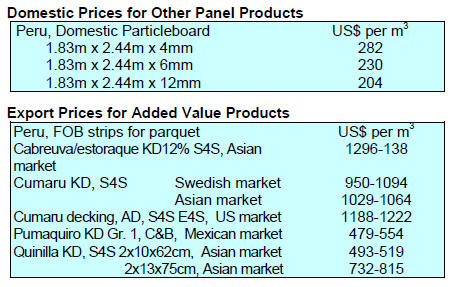 GUYANA
GUYANA
